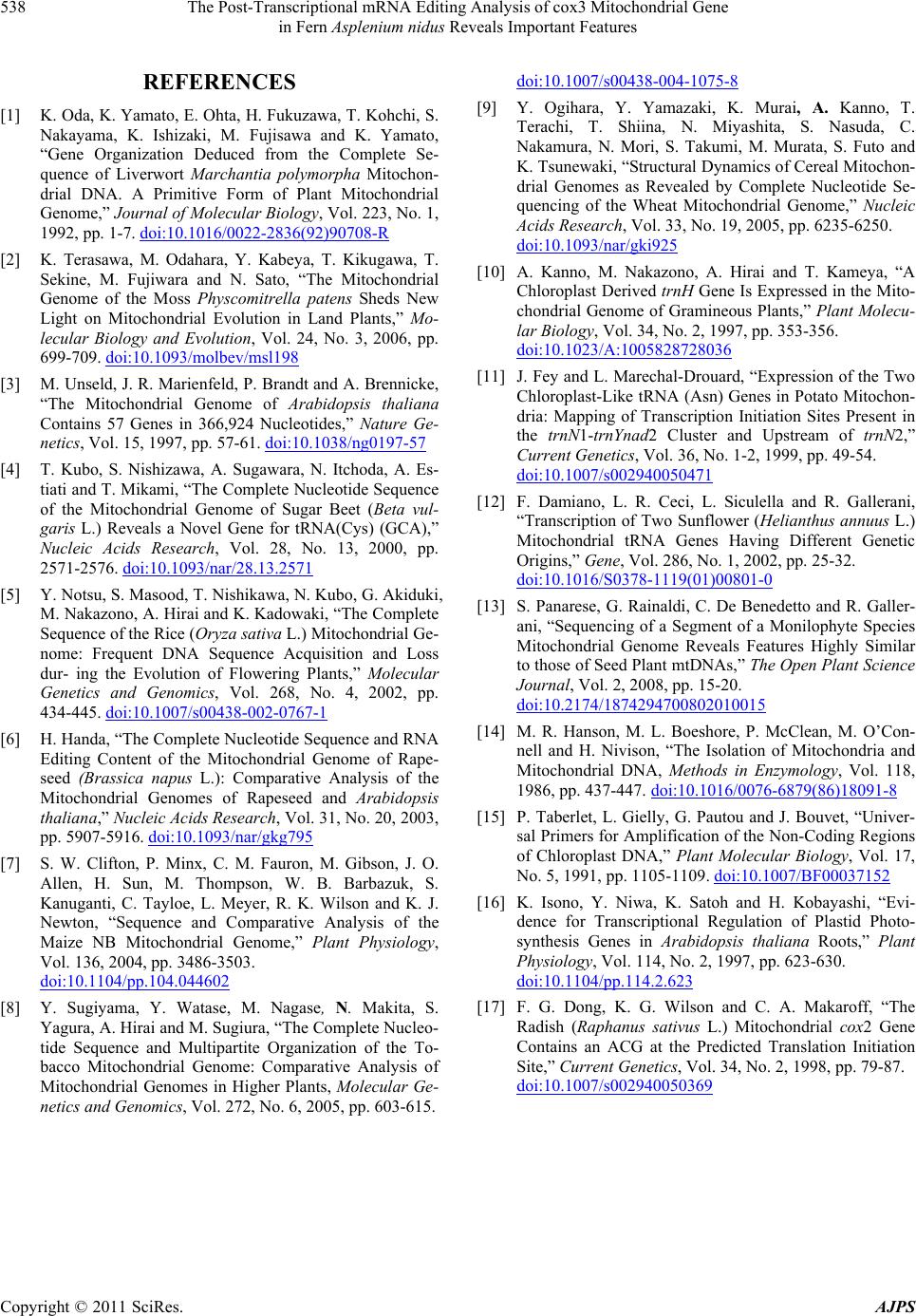
The Post-Transcriptional mRNA Editing Analysis of cox3 Mitochondrial Gene
in Fern Asplenium nidus Reveals Important Features
Copyright © 2011 SciRes. AJPS
538
REFERENCES
[1] K. Oda, K. Yamato, E. Ohta, H. Fukuzawa, T. Kohchi, S.
Nakayama, K. Ishizaki, M. Fujisawa and K. Yamato,
“Gene Organization Deduced from the Complete Se-
quence of Liverwort Marchantia polymorpha Mitochon-
drial DNA. A Primitive Form of Plant Mitochondrial
Genome,” Journal of Molecular Biology, Vol. 223, No. 1,
1992, pp. 1-7. doi:10.1016/0022-2836(92)90708-R
[2] K. Terasawa, M. Odahara, Y. Kabeya, T. Kikugawa, T.
Sekine, M. Fujiwara and N. Sato, “The Mitochondrial
Genome of the Moss Physcomitrella patens Sheds New
Light on Mitochondrial Evolution in Land Plants,” Mo-
lecular Biology and Evolution, Vol. 24, No. 3, 2006, pp.
699-709. doi:10.1093/molbev/msl198
[3] M. Unseld, J. R. Marien feld, P. Brandt and A. Brennicke,
“The Mitochondrial Genome of Arabidopsis thaliana
Contains 57 Genes in 366,924 Nucleotides,” Nature Ge-
netics, Vol. 15, 1997, pp. 57-61. doi:10.1038/ng0197-57
[4] T. Kubo, S. Nishizawa, A. Sugawara, N. Itchoda, A. Es-
tiati an d T. Mikami, “The Complete Nucl eotide Seque nce
of the Mitochondrial Genome of Sugar Beet (Beta vul-
garis L.) Reveals a Novel Gene for tRNA(Cys) (GCA),”
Nucleic Acids Research, Vol. 28, No. 13, 2000, pp.
2571-2576. doi:10.1093/nar/28.13.2571
[5] Y. Notsu, S. Masood, T. Nishikawa, N. Kubo, G. Akiduki,
M. Nakazono, A. Hirai and K. Kadowaki, “The Complete
Sequence of the Rice (Oryza sativa L.) Mitochondrial Ge-
nome: Frequent DNA Sequence Acquisition and Loss
dur- ing the Evolution of Flowering Plants,” Molecular
Genetics and Genomics, Vol. 268, No. 4, 2002, pp.
434-445. doi:10.1007/s00438-002-0767-1
[6] H. Handa, “The Complete Nucleotide Seque nce and RNA
Editing Content of the Mitochondrial Genome of Rape-
seed (Brassica napus L.): Comparative Analysis of the
Mitochondrial Genomes of Rapeseed and Arabidopsis
thaliana,” Nucleic Acids Rese arch, Vol. 31, No. 20, 2003,
pp. 5907-5916. doi:10.1093/nar/gkg795
[7] S. W. Clifton, P. Minx, C. M. Fauron, M. Gibson, J. O.
Allen, H. Sun, M. Thompson, W. B. Barbazuk, S.
Kanuganti, C. Tayloe, L. Meyer, R. K. Wilson and K. J.
Newton, “Sequence and Comparative Analysis of the
Maize NB Mitochondrial Genome,” Plant Physiology,
Vol. 136, 2004, pp. 3486-3503.
doi:10.1104/pp.104.044602
[8] Y. Sugiyama, Y. Watase, M. Nagase, N. Makita, S.
Yagura, A. Hirai and M. Sugiura, “The Complete Nucle o-
tide Sequence and Multipartite Organization of the To-
bacco Mitochondrial Genome: Comparative Analysis of
Mitochondrial Genomes in Higher Plants, Molecular Ge-
netics and Genomics, Vol. 272, No. 6, 2005, pp. 603-615.
doi:10.1007/s00438-004-1075-8
[9] Y. Ogihara, Y. Yamazaki, K. Murai, A. Kanno, T.
Terachi, T. Shiina, N. Miyashita, S. Nasuda, C.
Nakamura, N. Mori, S. Takumi, M. Murata, S. Futo and
K. Tsunewaki, “Structural Dynamics of Cereal Mitochon-
drial Genomes as Revealed by Complete Nucleotide Se-
quencing of the Wheat Mitochondrial Genome,” Nucleic
Acids Research, Vol. 33, No. 19, 2005, pp. 6235-6250.
doi:10.1093/nar/gki925
[10] A. Kanno, M. Nakazono, A. Hirai and T. Kameya, “A
Chloroplast Derived trnH Gene Is Expressed in the Mito-
chondrial Genome of Gramineous Plants,” Plant Molecu-
lar Biology, Vol. 34, No. 2, 1997, pp. 353-356.
doi:10.1023/A:1005828728036
[11] J. Fey and L. Marechal-Drouard, “Expression of the Two
Chloroplast-Like tRNA (Asn) Genes in Potato Mitochon-
dria: Mapping of Transcription Initiation Sites Present in
the trnN1-tr nYnad2 Cluster and Upstream of trnN2,”
Current Genetics, Vol. 36, No. 1-2, 1999, pp. 49-54.
doi:10.1007/s002940050471
[12] F. Damiano, L. R. Ceci, L. Siculella and R. Gallerani,
“Transcription of Two Sunflower (Helianthus annuus L.)
Mitochondrial tRNA Genes Having Different Genetic
Origins,” Gene, Vol. 286, No. 1, 2002, pp. 25-32.
doi:10.1016/S0378-1119(01)00801-0
[13] S. Panarese, G. Rainaldi, C. De Benedetto and R. Galler-
ani, “Sequencing of a Segment of a Monilophyte Species
Mitochondrial Genome Reveals Features Highly Similar
to those of Seed Plant mtDNAs,” The Open Plant Science
Journal, Vol. 2, 2008, pp. 15-20.
doi:10.2174/1874294700802010015
[14] M. R. Hanson, M. L. Boeshore, P. McClean, M. O’Con-
nell and H. Nivison, “The Isolation of Mitochondria and
Mitochondrial DNA, Methods in Enzymology, Vol. 118,
1986, pp. 437-447. doi:10.1016/0076-6879(86)18091-8
[15] P. Taberlet, L. Gielly, G. Pautou and J. Bouvet, “Univer-
sal Primers for Amplification of the Non-Coding Regions
of Chloroplast DNA,” Plant Molecular Biology, Vol. 17,
No. 5, 1991, pp. 1105-1109. doi:10.1007/BF00037152
[16] K. Isono, Y. Niwa, K. Satoh and H. Kobayashi, “Evi-
dence for Transcriptional Regulation of Plastid Photo-
synthesis Genes in Arabidopsis thaliana Roots,” Plant
Physiology, Vol. 114, No. 2, 1997, pp. 623-630.
doi:10.1104/pp.114.2.623
[17] F. G. Dong, K. G. Wilson and C. A. Makaroff, “The
Radish (Raphanus sativus L.) Mitochondrial cox2 Gene
Contains an ACG at the Predicted Translation Initiation
Site,” Current Genetics, Vol. 34, No. 2, 1998, pp. 79-87.
doi:10.1007/s002940050369